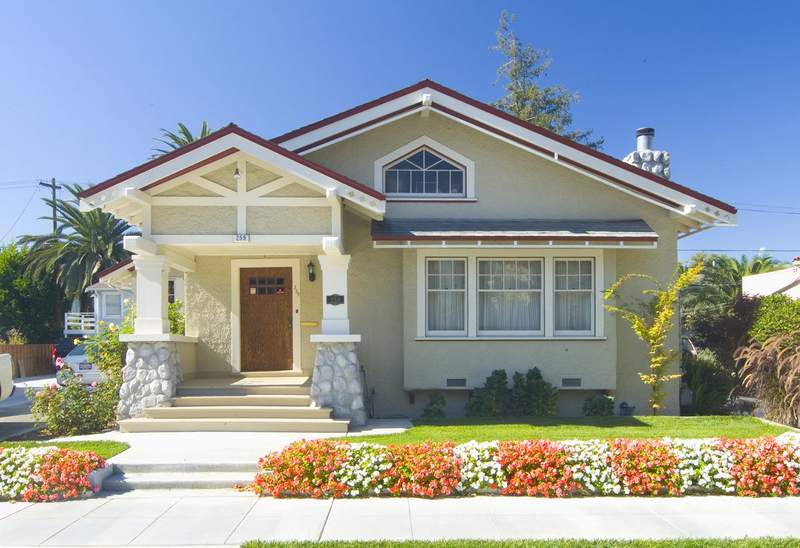Even if you have your heart set on a certain location or property, your budget plays a big part in deciding which home you end up buying. That’s why it’s important to answer the question: “How much can I afford for a house?”
Income is just one piece of the puzzle when it comes to buying a home and getting a mortgage. Other factors that affect whether you’re approved — and for how much — include your debt-to-income ratio, down payment, and credit score.
Here’s how to figure out what you can afford as a homebuyer:
- Personal Factors Affecting How Much House You Can Afford
- Loan Factors Affecting How Much House You Can Afford
- Ongoing Costs Affecting How Much House You Can Afford
- Estimating How Much Mortgage You Might Qualify For
- Tips for Affording More Home
- When To Keep Renting Instead of Buying a Home
- FAQ: How Much House Can I Afford?
- The Bottom Line on How Much House You Can Afford
Personal Factors Affecting How Much House You Can Afford
A handful of factors influence whether you’ll be approved for a mortgage, what interest rate you’ll pay, and other fees you may have to pay.
Your debt-to-income ratio
To evaluate your ability to repay a mortgage, mortgage lenders will calculate your debt-to-income ratio, which measures how much of your gross monthly income goes toward paying debt obligations. A high DTI ratio may suggest that you’re overextended.
To calculate your DTI ratio, add up your total monthly debt payments, divide that by your gross monthly income, and then convert the result to a percentage. For example, say you have credit card, car loan, and student loan payments that total $1,200 per month, and you earn $5,500 per month before taxes. Divide $1,200 by $5,500 to get 0.22. Multiply 0.22 by 100 for a DTI ratio of 22%.
You can use a DTI ratio calculator to assess your ability to make mortgage payments.
The 28/36 rule
Lenders use two ways to look at DTI ratios. A front-end ratio considers only the amount of your mortgage payment in relation to your income. A back-end ratio includes all your debts in the calculation. The maximum allowable DTI ratio varies, but lenders generally follow the 28/36 rule.
According to this rule, you shouldn’t spend more than 28% of your gross monthly income on your mortgage, and your total debt payments shouldn’t exceed 36%. In other words, the maximum front-end ratio is 28%, and the maximum back-end ratio is 36%.
Front-End DTI Ratios vs. Back-End DTI Ratios
| Monthly Income | Maximum Mortgage Payment (28% of Income) | Maximum Total Debt Payments (36% of Income) |
| $2,500 | $700 | $900 |
| $3,000 | $840 | $1,080 |
| $3,500 | $980 | $1,260 |
| $4,000 | $1,120 | $1,440 |
| $4,500 | $1,260 | $1,620 |
| $5,000 | $1,400 | $1,800 |
| $5,500 | $1,540 | $1,980 |
| $6,000 | $1,680 | $2,160 |
| $6,500 | $1,820 | $2,340 |
| $7,000 | $1,960 | $2,520 |
| $7,500 | $2,100 | $2,700 |
| $8,000 | $2,240 | $2,880 |
Some lenders prefer 28/41 as the rule of thumb instead, allowing you to carry more debt. It depends on the lender, so you should shop around and compare mortgage offers.
Your credit score
In addition to helping you qualify for a mortgage, your credit score affects the interest rate that lenders will offer you on a loan. Higher credit scores generally correspond to lower mortgage rates.
“If your credit scores are high, it tells lenders that you have paid your credit card bills on time and that you are responsible with your money,” says Shelby McDaniels, channel director of corporate home lending at Chase in Columbus, Ohio. On the other hand, a low credit score could signal that you’ve had trouble repaying debts in the past.
For a conventional mortgage, you’ll need a credit score of at least 620. Other types of loans set their own minimum credit score requirements.
Your reserves
Having money in reserve is important because homeownership is expensive. Before you get a mortgage, you need to think about your savings. Do you have an emergency fund? How will you handle an unexpected home repair, like a broken water heater?
You also need to consider the fact that you’ll have a monthly mortgage payment to make even if you lose your job or other source of income. Make sure you have enough cash on hand to handle unexpected expenses and to keep paying your mortgage if you lose your job.
For example, imagine you have a monthly mortgage payment of $2,250. Here’s how much you need to have saved to keep paying the bill:
Example of Reserves Needed to Make a $2,250 Mortgage Payment
| Savings | Number of Months Before Depleting Reserves |
| $2,250 | 1 |
| $9,000 | 4 |
| $13,500 | 6 |
| $27,000 | 12 |
Remember that you’ll also need emergency savings to pay for other living expenses, such as food and utilities.
Loan Factors Affecting How Much House You Can Afford
Your credit score and savings will help you answer the question: “How much mortgage can I afford?” You also have to know how the details of your loan affect your monthly payment.
Your down payment
The larger your down payment, the lower your monthly payment will be, because you’re paying a larger portion of the price upfront and borrowing less to buy the home.
Saving for a larger down payment also can help you avoid additional costs, such as mortgage insurance, and lower your interest rate. It boosts your equity in the home and makes it easier to borrow against your home in the future.
How Equity Changes Based on the Down Payment on a $300,000 Home
| Down Payment | Starting Home Equity |
| $15,000 | 5% |
| $30,000 | 10% |
| $60,000 | 20% |
| $75,000 | 25% |
Your loan amount
The amount you borrow depends on two factors: the cost of the home and the size of your down payment. The less you borrow, the less you’ll pay each month. That means larger down payments and less-expensive homes can help you reduce your monthly mortgage bill.
Your loan term
The two most popular mortgage terms are 15 and 30 years. Generally, longer loan terms have lower monthly payments and cost more overall, while shorter loan terms have higher monthly payments and cost less overall.
Monthly Payment With a 15-Year vs. 30-Year Mortgage at 7% Interest
| Loan Amount | Monthly Payment for 15-Year Loan | Monthly Payment for 30-Year Loan |
| $200,000 | $1,798 | $1,331 |
| $300,000 | $2,696 | $1,996 |
| $400,000 | $3,595 | $2,661 |
| $500,000 | $4,494 | $3,327 |
Your interest rate
Each month, your mortgage payment covers all the accrued interest plus a portion of the principal. Higher interest rates mean more interest accrues, which correlates with a higher monthly payment.
Fixed-rate mortgage vs. ARM
One major choice that borrowers have to make is between a fixed-rate and adjustable-rate mortgage. Fixed-rate mortgages have interest rates that don’t change, while ARMs have rates that change from time to time and can increase.
Typically, ARMs have lower initial interest rates than fixed-rate mortgages, leading to cheaper payments at first. However, ARM payments can increase during the loan term. Fixed-rate loans have the same monthly payment for the life of the loan, offering predictable monthly payments.
Your loan type
The type of mortgage you choose affects how much home you can afford. Some loan types also make it easier for certain homebuyers to qualify, including first-time buyers.
Here’s a closer look at the different loan options.
Conforming conventional loans
A conventional mortgage is a home loan that’s not part of any government program. Conventional loans that meet the requirements set by the Federal Housing Finance Agency are known as conforming loans.
Conforming loans have a maximum amount of $726,200 for single-unit properties in most locations and $1,089,300 in high-cost areas. The FHFA has an online map showing those high-cost areas.
Some lenders allow borrowers to put down as little as 3% for conforming loans, though a down payment of 20% is required to avoid private mortgage insurance. Borrowers typically need a credit score of at least 620 to qualify. The loans set a maximum DTI ratio of 50% for automatically underwritten loans, and 36% to 45% for manually underwritten loans.
Jumbo loans
A jumbo mortgage — aka a nonconforming conventional loan — is one that exceeds the FHFA limits. Due to their size, jumbo loans are riskier for lenders and often come with stricter requirements. Many lenders require a credit score of at least 720, along with a down payment of at least 20%.
FHA loans
Loans insured by the Federal Housing Administration have more-lenient requirements compared with conventional mortgages. Borrowers with a credit score of at least 580 can put down as little as 3.5%, while borrowers with scores between 500 and 579 must put down at least 10%. The maximum back-end DTI ratio for FHA loans is 43%.
There are limits on how much you can borrow with an FHA loan, which for one-unit homes have a maximum of $472,030 in low-cost areas and a maximum of $1,089,300 in high-cost areas. Limits are set by county, and you can look up maximum loan limits at the FHA’s website.
FHA borrowers also need to pay annual mortgage insurance premiums, which are calculated based on their down payment and the loan balance.
VA loans
Loans insured by Veterans Affairs are available to eligible service members, veterans, and surviving spouses. Qualified borrowers can put zero down, and the VA establishes no minimum credit score, though the private lenders who issue the loans may set one.
There’s also a one-time VA funding fee. For first-time VA borrowers, the fee is 1.4% to 2.3% of the loan amount and depends on how much you put down.
USDA loans
Loans insured by the Department of Agriculture help low- and middle-income borrowers afford housing in eligible rural areas. There’s typically no down payment required, and the USDA sets no minimum credit score. USDA borrowers need to pay an upfront guarantee fee of up to 1% of the loan amount, and an annual fee of up to 0.35% of the mortgage balance.
Your closing costs
On top of the down payment, you’ll need to cover closing costs. Closing costs are upfront fees you pay when you buy a home, such as loan fees, home inspection fees, home appraisal fees, title insurance fees, and other costs.
These typically range between 2% and 5% of the purchase price of the home. For example, if you’re buying a $250,000 home, you can expect to need between $5,000 and $12,500 to handle closing costs.
Ongoing Costs Affecting How Much House You Can Afford
Although your mortgage has a big impact on whether you can afford a home, it’s not the only expense to consider. There are many costs associated with owning a home.
Property taxes
Homeowners must pay property taxes, which usually are assessed each year as a percentage of the home’s value. Nationally, the property tax rate varies from 0.18% to 1.89% of the home’s value.
Homeowners insurance
Homeowners insurance covers your home against everything from natural disasters to burglars. Most lenders require that you carry this protection, which on average costs $1,272 each year.
Utilities
You’ll have to pay monthly utility bills — including electricity, water, and gas — which add to the ongoing cost of homeownership. The average monthly utility costs in the U.S. are around $600.
HOA fees
If you buy a house, condo, or townhome in a homeowners association, you will need to pay monthly HOA fees, and also may have to deal with special assessments. Fees can vary significantly, but the average HOA fee is $250 per month for a single-family home.
Private mortgage insurance
Private mortgage insurance protects your lender in the event that you default on your loan. Typically, you only have to pay PMI if you have a conventional loan and your down payment is less than 20% of the home’s value. PMI usually costs between $30 and $70 per month for every $100,000 you borrow.
Maintenance and repairs
You’ll want to repair and keep your home in top condition, lest it becomes less appealing to live in and depreciates in value. Expect to spend 1% to 2% of your home’s value on maintenance each year.
Estimating How Much Mortgage You Might Qualify For
Using a mortgage calculator can be helpful when you’re trying to figure out how much house you qualify for.
For example, imagine you have $1,200 in monthly debts, such as car and student loan payments. You plan to use the 28% rule to determine your maximum mortgage payment when you get a loan with a 10% down payment and a 7% interest rate. How much you might qualify for depends on your monthly income:
Example of How Much Mortgage You Might Qualify For
| Monthly Pretax Income | Remaining Income After $1,200 Debt Payments | Maximum Monthly Mortgage Payment (28% Rule) | Maximum Home Value (10% Down Payment and 7% Interest With 30-Year Loan) |
| $3,500 | $2,000 | $560 | $93,555 |
| $4,500 | $3,000 | $840 | $140,333 |
| $5,500 | $4,000 | $1,120 | $187,111 |
| $6,500 | $5,000 | $1,400 | $233,889 |
| $7,500 | $6,000 | $1,680 | $280,556 |
Tips for Affording More Home
If you want to be able to afford a more expensive home, there are a few paths you can take.
Improve your credit score
A better credit score can help you secure lower interest rates, reducing your monthly mortgage payment. If your credit score isn’t where you want it to be, there are several ways to help improve your score, including:
- Paying all your bills on time. Payment history is the most heavily weighted category, making up 35% of your credit score. One of the best things you can do to build good credit is to make all your payments on time and in full.
- Paying down your debts. Improving your DTI ratio is good for your credit score. The amounts you owe make up 30% of your score, so decreasing your outstanding debt can boost your credit.
- Avoiding new credit applications. When you apply for a loan or credit card, the lender reviews your credit file. This results in what’s known as a hard inquiry, which can hurt your score. A new account also decreases the average length of your credit history — another negative mark.
Improve your DTI ratio
A lower DTI ratio could help you pay less in interest or increase your chances of getting accepted for a loan. Given that DTI ratios look at both income and debt, there are two approaches you can take to improve yours:
- Reduce your existing debt. For example, you could work on paying off a credit card balance. This would lower your total monthly debt payments.
- Increase your income. If you successfully ask for a raise at work or take on a side hustle, your earnings will increase relative to your debt payments.
Save for a larger down payment
The more you put down on a home, the less you have to borrow, which means lower monthly payments.
For example, imagine you buy a $250,000 home with a 30-year loan at a 7% interest rate. With a 20% — or $50,000 — down payment, you’ll pay $1,331 per month. A 10% down payment — or $25,000 — leads to a monthly payment of $1,497, which is about $150 more each month. Plus, you might have the added cost of PMI with the smaller down payment.
Saving can be difficult, and it takes time, but it has a big impact on your ability to afford a more expensive home.
When To Keep Renting Instead of Buying a Home
Homeownership can be a path to building wealth, but buying a home isn’t always the right move. It could make more sense financially to keep renting vs. buying a home if you live in a market with a high price-to-rent ratio. The price-to-rent ratio is the median home price in a market divided by the median annual rent in the same market.
Another situation where it might make sense to continue renting is if you anticipate a positive change to your finances. For example, you could wait to buy if you’re expecting a promotion or raise at work, which will increase your income.
FAQ: How Much House Can I Afford?
Here are some answers to some common questions about budgeting for a house.
Using the 28% rule, you can afford a maximum monthly payment of $1,750. Assuming you get a loan at a 7% interest rate with a 10% down payment, you could afford a home worth up to $292,222.
It’s usually a good idea to buy a home below your budget. If you get the most expensive home you can afford, you’ll struggle to deal with changes in your income and have less flexibility to focus on other financial goals.
Being a first-time homebuyer may affect how much home you can afford. Some lenders offer lower rates for first-time buyers, and first-time buyer programs can provide grants or assistance in areas like your down payment.
The Bottom Line on How Much House You Can Afford
The process of buying a home starts well before attending open houses and submitting a mortgage application. There are multiple factors to consider that affect your ability to afford a home and get approved for a loan. So, before setting your sights on a particular property, spend some time crunching the numbers and deciding what the right mortgage looks like for your financial situation.
T.J. Porter contributed to the reporting of this article.






